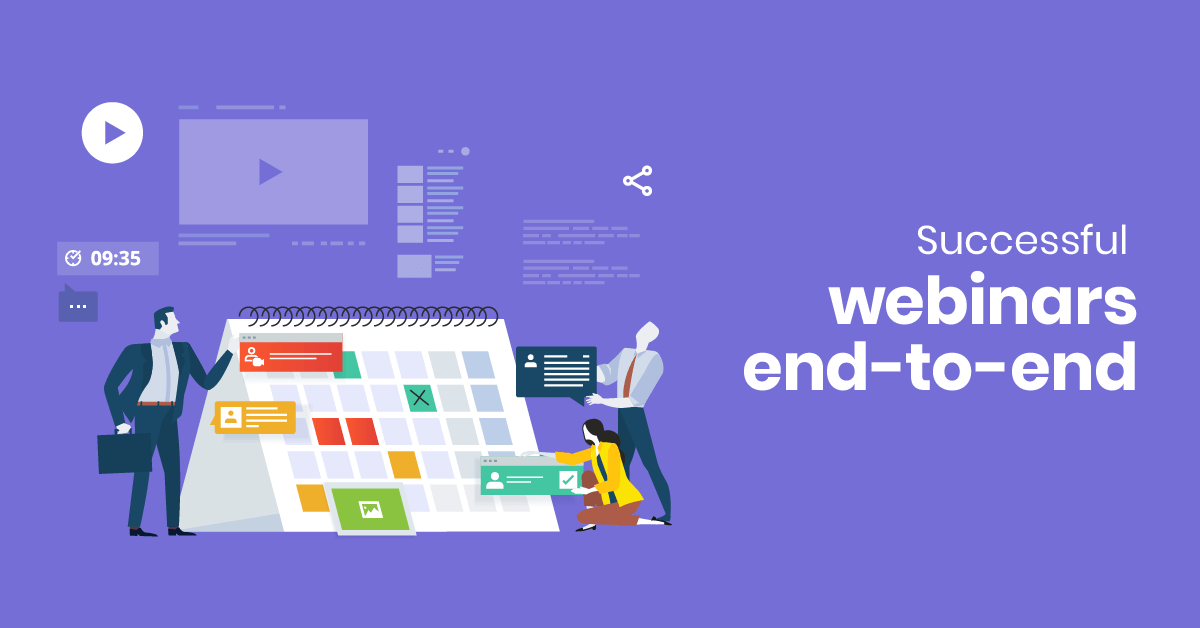But the questions shouldn’t stop there. Learning is an ongoing process, and the steps you take before and after an online training session deserve attention too.
Whether you’re training employees, customers, or external partners, preparing for and following up on your webinar will add value and increase learner engagement. The key is to understand why pre- and post-webinar experiences matter and how to leverage both.
A well-delivered webinar doesn’t guarantee learning
The ultimate goal of your webinars is learning. For best results, you’ve got to look at the learning experience more holistically. There are a number of reasons to focus on what happens before and after the training as well as during. Consider the following:
- You can’t count on 100% online attention. People across industries are experiencing Zoom fatigue. They’re tired of being on video calls, and remote environments invite distraction. Odds are against you having learners’ full attention during a webinar. But you can make up for the lapses with added preparation and follow-up.
- You shouldn’t forget about the forgetting curve. People quickly forget new content after they learn it. Research shows it’s an exponential curve, where people lose the most retention in the first few days after learning. Timely pre- and post-training activities combat the curve by making the content stickier.
Training webinars shouldn’t just be one-off events if you really want them to be effective. There’s plenty you can do before and after to ensure their success. The right LMS can integrate your video conference with useful features to streamline pre- and post-training support.
How to prepare before a webinar
There’s no question that hosts should prepare in advance to lead a successful event. They might brush up on presentation tips and skills, practice delivery, and test equipment and software.
But you don’t have to rely only on the host. You can and should start engaging learners before the webinar begins. When people show up with a good sense of the course’s purpose and value, they’ll get more out of it.
Here are three ways you can prepare learners for success in advance:
1. Offer prework
Help people invest in their learning by assigning prework. You may ask clients to come prepared with a specific use case to explore. Or, have employees get familiar with a new product before you train them on customer service and troubleshooting.
Use different mediums to make prework interesting and keep it from feeling like a chore. Share links to articles or videos with relevant information to help participants think about what they want to get out of the training.
This way, you can also save time during the webinar and go straight to the most interesting parts of training instead of spending time to explain what this session is about, who’s it for, and so on. When you give people a taste of the content, you pique their interest and prepare them to learn about a topic in-depth.
2. Explain why the content matters
When you invite people to join your webinar, don’t just give them an overview of the content. Use invitations and announcements to explain how learners will benefit by tying the content into things they care about.
For instance, share with employees how the skills apply to specific job-related tasks. Tell your clients how your training will help them increase their market share. Or, show partners that the processes they’ll learn will make their interactions with you more efficient and speed up business results.
3. Survey learners
Use quizzes and polls to engage people with your topic in advance. For example, ask employees to rate the need for the skills in different areas of their jobs. This will get them thinking about the value of the content you’ll share.
Or, test people’s existing understanding of the topic to create anticipation for learning. They’ll see the gaps in their knowledge and come to the training ready to fill them.
Survey results can also be immensely helpful as you plan out how to run a webinar. You’ll get a sense of where learners are so you can tailor content to their interests or pain points.

How to follow up after a webinar
Post-training activities combat the forgetting curve and give people a chance to apply what they learned. Here are five things you can do once the webinar ends to keep learning fresh for external audiences, or employees and partners:
1. Share resources immediately
Give learners the resources to review the content or continue their learning. And do so immediately to maintain the learning momentum you created in the webinar. You may share a recording of the session, worksheets that help people prepare to use the skills, or additional information through videos and articles.
Set up your LMS to email registrants with the list of resources. Or, give them a link to a website with all the information. Whatever your plan, finish up your webinar by letting people know what resources will be available and how they can access them.
2. Schedule follow-up assignments
Like training, reinforcement should not be a one-off event. Repetition builds habits and strengthens memory. Set up follow-up assignments for a week or two after the training—then at regular intervals as appropriate.
Send out refresher quizzes or challenges to complete. Or, at the end of the webinar, ask learners to write down a goal for applying the information back on the job. Then, invite them to a follow-up session to report on their progress and share insights.
3. Share post-training progress
Boost employees’ motivation and keep the skills front of mind by sharing progress at set intervals. For instance, if you teach skills for improving customer satisfaction scores, post those scores regularly.
Seeing those numbers improve over time will remind employees of the skills’ value. And it will renew their commitment to their training.
4. Keep communication lines open
This is especially relevant when you’re training customers through webinars. Give them some way (a website or an email address) to reach out with questions or to share successes. And keep them in the loop with regular communication about upcoming events they may be interested in.
For internal audiences, you could send a post-training survey where participants can share their feedback about the webinar and what they’d like to see in the future. This way, you show that webinars are not a one-way street; learners have an active role in shaping the content and the learning outcomes.
5. Follow up and answer webinar questions
Often, questions come up during training that you don’t have time to address in-depth. Ensure learners feel heard and have their questions answered by establishing a process for dealing with them.
Acknowledge these inquiries as they come up or encourage people to submit them through chat. Let them know you’ll address them after the training. Then send out answers via emails, videos, or a blog post all participants will have access to.
Effective webinars are planned and measured for success
When it comes to webinars, metrics and engagement are important for real learning. If your goal is simply to reach a certain attendance rate, even just a catchy webinar title might do the work for you. But if your goal is for people to actually learn, then you need to pay attention to the entire learning journey—not just the one hour the webinar lasts.
For a truly effective process, after you’ve done all you can to set the webinar up for success, measure the results. Survey people about their experience with polls and activities. Use the metrics you glean to see if you’re hitting your goals and know where you can add support and improve learning. Getting the full picture will help you offer the best possible learning experience.



